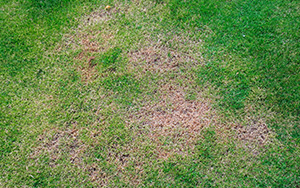
What Is Brown Patch Fungus?
Brown Patch Fungus, scientifically known as Rhizoctonia Solani, is a common turfgrass disease that thrives in warm, humid climates like Florida. It typically appears as circular or irregular brown patches ranging from a few inches to several feet in diameter. Brown Patch Fungus is especially detrimental to Bermuda, zoysiagrass, and St. Augustine grass.
Identifying Brown Patch Fungus
Identifying brown patch fungus involves more than just spotting brown areas on your lawn. Look for these distinctive signs:
- Circular Patches: Patches form in circular shapes, ranging in size from a few inches to several feet. Brown Patch Fungus can range in color from yellow to reddish brown to brown as it wreaks havoc on your lawn.
- Distinct Borders: The patches have well-defined dark brown borders, which separate the affected area from healthy grass.
- Grass Blade Symptoms: This lawn disease affects grass from the inside out. Individual grass blades within the patches might display lesions or water-soaked spots and can be pulled up easily.
- Weather Conditions: Brown patch fungus is more prevalent during periods of high humidity and warm temperatures between 75-85 degrees.
If you notice any kind of spotting in your yard, don’t hesitate to call the professionals!
How Can I Prevent Brown Patch Fungus?
An early infestation can be hard to identify, and by the time Brown Patch Fungus is distinctly identifiable, it may already have caused extensive lawn damage. The best Brown Patch Fungus treatment is to adjust your lawn and shrub care practices.
- Mow regularly: Maintain your grass at the recommended height for its specific variety.
- Adequate Irrigation: water between 2 a.m. and 7 a.m. only once or twice a week depending on the season.
- Soil Aeration: Aerating your lawn improves soil drainage and reduces compaction, making it less conducive to fungal development.
- Balanced Fertilization: Avoid excessive nitrogen, especially during the active growing season, as it can promote fungal growth.
- Trim Trees and Shrubs: Prune overhanging branches and shrubs to allow proper air circulation. Good airflow reduces humidity levels, making it harder for the fungus to thrive.
- Remove Debris: Regularly clean up fallen leaves, grass clippings, and other debris from your lawn. These can create a damp environment, encouraging fungal growth.
If Brown Patch Fungus has taken hold in your lawn, a professional-grade fungicide can be applied for temporary relief while lawn care practices are adjusted for long-term prevention.
Professional Lawn Care You Can Trust
At Sorko Services, we understand that lawn care can be overwhelming, which is why we’re here to help. Our expertly trained team will partner with you to create a personalized plan of action to keep your lawn lush, green, and free from pests and fungal diseases. Let us take care of your lawn, so you can spend more time enjoying where you live. Contact us today and get started with a free estimate!
Signs of Brown Patch Fungus in Central Florida
Serving Greater Orlando, Sanford and Kissimmee
Sanford | Orlando | Poinciana | Ocala | St Cloud | Winter Garden | Clermont | DeLand | Winter Springs | New Smyrna Beach | Winter Park
Orange County | Seminole County | Lake County | Osceola County | Volusia County | Polk County | Marion County | Brevard County
Home » Signs of Brown Patch Fungus
